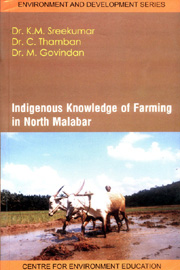Book contents
- Frontmatter
- Contents
- Foreword
- Preface
- Acknowledgements
- List of Photographs and Illustrations
- List of Tables
- List of Plants
- 1 Introduction
- 2 Agricultural Scenario in North Malabar
- 3 Farming Related Rituals
- 4 Rice
- 5 Coconut
- 6 Arecanut
- 7 Black Pepper
- 8 Cashew
- 9 Fruit Crops
- 10 Wild Fruits
- 11 Rubber
- 12 Spices
- 13 Tuber Crops
- 14 Vegetable Crops
- 15 Natural Resource Management
- 16 Indigenous Farm Implements
- 17 Miscellaneous Practices
- 18 Conclusion
- References
- Annexure I
- Annexure II
14 - Vegetable Crops
Published online by Cambridge University Press: 05 November 2011
- Frontmatter
- Contents
- Foreword
- Preface
- Acknowledgements
- List of Photographs and Illustrations
- List of Tables
- List of Plants
- 1 Introduction
- 2 Agricultural Scenario in North Malabar
- 3 Farming Related Rituals
- 4 Rice
- 5 Coconut
- 6 Arecanut
- 7 Black Pepper
- 8 Cashew
- 9 Fruit Crops
- 10 Wild Fruits
- 11 Rubber
- 12 Spices
- 13 Tuber Crops
- 14 Vegetable Crops
- 15 Natural Resource Management
- 16 Indigenous Farm Implements
- 17 Miscellaneous Practices
- 18 Conclusion
- References
- Annexure I
- Annexure II
Summary
Vegetable cultivation was traditionally followed in most of the villages of North Malabar region. Traditional vegetables constituted a prominent part of the dietary habits of the people, and a large number of crops and varieties were cultivated with a wide range of traditional practices. The main season for vegetable cultivation has been during the summer months, after the cessation of North East monsoon in rice fallows. During rainy months also some vegetable crops were raised in welldrained open areas in the garden land.
Cucumber Cultivation in Summer Season (Earppu Vellan)
Sowing of cucumber is done on the auspicious occasion of Makaram 28th (Earppu). Farmers believe that sowing should be done in the waning phase of the moon. If sowing is done in the waxing phase of the moon, flowering also will take place in the waxing phase resulting in production of large number of male flowers, a phenomenon known as malappookettal. Fields are ploughed well, pits taken, farm yard manure and wood ash incorporated and seeds sown. At three leaves stage, thinning and second application of farm yard manure and ash will be done.
At vining stage, interspaces are dug and clods broken and earthing up is carried out done on 18th day after sowing. The interspaces are covered with dry leaves collected from mango or cashew orchards. Farmers believe that more female flowers are formed on lateral branches of the main vine, and encourage lateral branch production by withholding irrigation for two to three days or by coiling the main vine.
- Type
- Chapter
- Information
- Indigenous Knowledge of Farming in North Malabar , pp. 114 - 121Publisher: Foundation BooksPrint publication year: 2006
- 1
- Cited by

